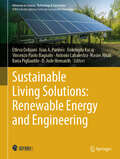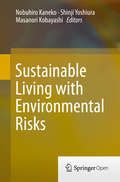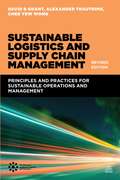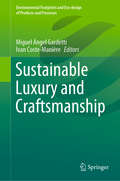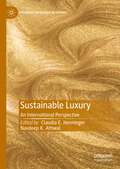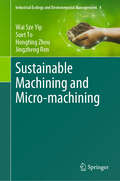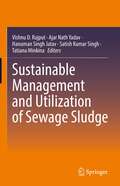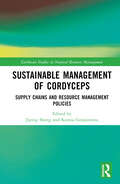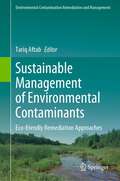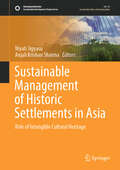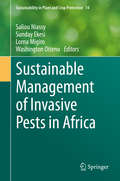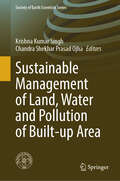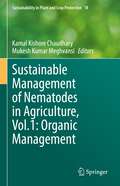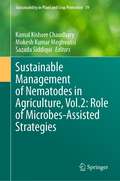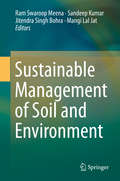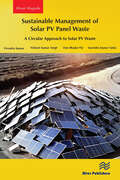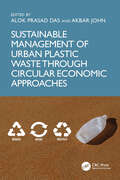- Table View
- List View
Sustainable Living Solutions: Renewable Energy and Engineering (Advances in Science, Technology & Innovation)
by Ivan A. Parinov D. Jude Hemanth Hasim Altan Ilaria Pigliautile Etleva Dobjani Vincenzo Paolo Bagnato Enkelejda Kucaj Antonio LabalestraThis book includes topics that explore diverse and innovative aspects of architectural design, urban planning, infrastructure, and engineering. The "Values Trilogy Design Philosophy" emphasizes the harmonious integration of sustainability, cost-effectiveness, and artistic expression in architectural projects. "DIGIT-ACCESS" explores a digital gateway to enhance accessibility to heritage architectures. The influence of biomimicry and biophilia on sustainable urban planning is examined, along with the application of biomimetic approaches in smart city design and traditional architecture in Saudi Arabia's Asir region. An analytical study investigates zero-energy concepts in high-rise buildings, while another contrasts the thermal performance of various insulation systems in hot-desert climates. The role of interior design in fostering creativity and cultural enrichment in performance arts academies is highlighted, alongside an architectural appraisal of user perceptions toward Tamil Nadu Housing Board (TNHB) low-income housing schemes. In the realm of electrical, mechanical engineering, and fabrication, this book covers advanced topics such as reducing peak average power ratio in OFDM systems for cognitive radio, nonlinear buckling analyses of corrugated steel plate shear walls, and accelerated corrosion testing of carbon steel. The mechanical characteristics of sustainable rigid pavement using sintered fly ash aggregate are explored, as well as the impact of fiberglass reinforced concrete on sustainable design. Additional studies include the evaluation of water resistance in glass-modified concrete, the effects of laser treatment on waste poly(aramid) fiber for 3D printed composites, and the polymerization of copperas into polyferric sulfate for leachate treatment. Lastly, a thermogravimetric evaluation and kinetic study of pyrolysis in commercialized timber species in Peru provide insights into sustainable material behavior.
Sustainable Living with Environmental Risks
by Nobuhiro Kaneko, Shinji Yoshiura and Masanori KobayashiWe are not free from environmental risks that accompany the development of human societies. Modern economic development has accelerated environmental pollution, caused loss of natural habitats, and modified landscapes. These environmental changes have impacted natural systems: water and heat circulation, nutrient cycling, and biodiversity. These changes in natural systems degrade ecosystem services and subsequently increase environmental risks for humans. Environmental risks, therefore, are not only human health risks by pollution, climatic anomalies and natural disasters, but also degradation of ecosystem services on which most people are relying for their lives. We cannot entirely eliminate the risks, because it is not possible to attain zero impact on the environment, but we need to find a mechanism that minimizes environmental risks for human sustainably. This is the idea of the interdisciplinary framework of “environmental risk management” theory, which advocates harmony between economic development and environmental conservation. Based on this theory, the Sustainable Living with Environmental Risk (SLER) programme, adopted by the Japanese Ministry of Education (MEXT) as one of its strategic programmes, has been training graduate students at the Yokohama National University, Japan, from 2009 to 2013 to become future environmental leaders who will take the initiative in reducing the level of environmental risks and in protecting natural resources in the developing nations of Asia and Africa. This book provides students and teachers of this new academic field with a comprehensive coverage of case studies of environmental risks and their practical management technologies not only in Japan but also in developing nations in Asia and Africa.
Sustainable Local Development for Environmental and Social Sustainability (Human-Environment Interactions #11)
by Bhanwar Vishvendra Raj Singh Amit Kumar BatarThe world organizations, including national governments, have already recognized the importance of the Aichi Biodiversity Target, the Paris Agreement, Sustainable Development Goals (SDGs), Ecosystem-based Disaster Risk Reduction (Eco-DRR), Low Carbon Society. Therefore, there is an urgent need to act locally to tackle socio-economic, socio-ecological, socio-hydrological, and environmental conservation concerns in changing environments on a local to global scale and need to promote scientific solutions and common knowledge to achieve harmony between nature and humans under the threat of global climate change and the post-Covid-19 pandemic situation. For this purpose, the SLD approach is needed towards environmental and social sustainability. However, the SLD approach is challenging in terms of supply and demand of natural resources, resource depletion, socio-economic inequality, biodiversity loss, and climate change risk from local to the global scale, which vary based on different socio-economic, political, geographical, and cultural factors. Therefore, this book will highlight the environmental and social sustainability research by taking the local/regional case study. This book would also highlights the importance of policy interface at a local to global scale for environmental and social sustainability (ESS) in changing environments.
Sustainable Logistics and Supply Chain Management (Revised Edition)
by David B. Grant Chee Yew Wong Alexander TrautrimsAdopting sustainable practices is crucial for all businesses in the 21st century. Sustainable Logistics and Supply Chain Management is the essential guide to the principles and practices of sustainable logistics operations and the responsible management of the entire supply chain. Based on extensive research by experts in the field, this comprehensive book covers the whole scope of sustainable logistics. It provides carefully reviewed research-led applications and case studies that have been especially developed for this revised edition. Examining the subject in an integrated manner, this book examines all the key areas in sustainable logistics, including: sustainable product design and packaging; sustainable purchasing and procurement; cleaner production; environmental impact of freight transport; sustainable warehousing and storage; sustainable supply management; reverse logistics; and recycling; supply chain management strategy, and much more. A vital teaching resource for any course on sustainable logistics, this revised edition of Sustainable Logistics and Supply Chain Management includes valuable supporting online materials, including PPT presentations, chapter summaries, learning objectives, tips for teaching and in class activities.
Sustainable Luxury and Craftsmanship (Environmental Footprints and Eco-design of Products and Processes)
by Ivan Coste-Manière Miguel Ángel GardettiThis book explores the intricate relationship between luxury and craftsmanship, using brand-based case studies and consumer behavior to do so. In addition to revealing how the artification of luxury affects consumer behavior with branding and traditions, it discusses how sustainable luxury could not only offer a vehicle for more respect for the environment and social development, but could also be a metaphor for the cultures, art traditions, and innovations of various nationalities, continuing the legacy of local craftsmanship.
Sustainable Luxury: An International Perspective (Palgrave Advances in Luxury)
by Claudia E. Henninger Navdeep K. AthwalThis book addresses the issue of sustainability in the luxury industry, which has become a major topic of concern for brand managers, scholars, policy-makers, the media, and academia. Spanning 13 chapters, the authors provide insights from developed and developing countries, whilst at the same time exploring a variety of issues within sustainable luxury, the hidden value of secondhand, eco-luxury, circular economy principles and perceptions, ethical sourcing and eco-label strategies. All of which can be linked to the broader theme of SDG12: Responsible Production and Consumption. Thus, the book not only has a wide geographical scope but also brings together a collection of scholars spanning many disciplines such as marketing, management, textiles, fashion, economics, and digital media. Offering a combination of empirical and conceptual works, the book also provides important insights for future research enquiries.
Sustainable Luxury: Cases on Circular Economy and Entrepreneurship (Environmental Footprints and Eco-design of Products and Processes)
by Subramanian Senthilkannan Muthu Miguel Angel GardettiThis book highlights ten cases of entrepreneurship that – in the context of circular economy – have redefined the paradigm of luxury and the notion of exclusivity that it requires. It shows how, by using technology and a new consumption model, the ten companies have created novel business models for luxury, and more intelligent forms of use better-suited to modern times.
Sustainable Machining and Micro-machining (Industrial Ecology and Environmental Management #4)
by Jingzheng Ren Suet To Wai Sze Yip Hongting ZhouThis book explores the technical challenges and technological gaps in sustainable machining and micro-machining. It underscores the critical role of sustainability in manufacturing, a sector pivotal to addressing global environmental challenges. As micro-manufacturing expands, it mirrors traditional manufacturing environmental impact, prompting the need for sustainable strategies. The book delves into methodologies such as network analysis, text mining, and classification algorithms to help readers understand the interplay between machining parameters, stakeholders, and sustainability factors. It concludes with an analysis of the current status and future prospects of sustainable machining and micro-machining. Additionally, it highlights the importance of integrating sustainable manufacturing to enhance efficiency, reduce resource consumption, and meet the increasing demands from society and stakeholders for environmentally responsible manufacturing solutions. Finally, the book examines the current status and future perspectives of sustainable machining and micro-machining, offering a comprehensive view of how industries can reformulate their approaches to ensure continuous development and sustainability.
Sustainable Management Through Knowledge and Innovation: How to Develop a Strong Strategy in the Wine Industry (SpringerBriefs in Applied Sciences and Technology)
by Javier Martínez-Falcó Bartolomé Marco-Lajara Eduardo Sánchez-García Luis A. Millán-TudelaThis book explores multiple types of innovation within the modern wine industry and how it has developed historically. The book provides and extensive examination of the existing knowledge in this subject. This highlights the evolution of historical and contemporary trends and signposts the authoritative literature published and most important researchers active in the field. With this comprehensive approach, the book is a versatile resource for both scholars and industry professionals, akin to a "Swiss Army Knife" for all aspects of green innovation in the wine sector.
Sustainable Management and Utilization of Sewage Sludge
by Ajar Nath Yadav Satish Kumar Singh Vishnu D. Rajput Hanuman Singh Jatav Tatiana MinkinaThis book is devoted to sewage sludge, its sustainable management, and its use and implications on soil fertility and crop production. The book traces the main chemical and biological properties of sewage sludge, and covers topics such as sewage sludge biostabilization and detoxification, biological and thermochemical treatment technologies, emerging nutrient recovery technologies, the role of microorganisms in sewage sludge management, and the sustainable use of sewage sludge as fertilizer in agriculture. The book offers a valuable asset for researchers, scholars and policymakers alike.
Sustainable Management of Cordyceps: Supply Chains and Resource Management Policies (Earthscan Studies in Natural Resource Management)
by Ksenia Gerasimova Jiping ShengThis book examines the challenges of sustainably managing and conserving Cordyceps sinensis, a rare species of fungus largely grown in Tibet, currently on the brink of extinction.As one of the most expensive commodities in the world, particularly valued for its medicinal properties in China, the price of Cordyceps has risen by over 900% since the 1970s. This has made it a very lucrative resource for farmers, many of whom are struggling to produce sufficient food to sustain themselves. Naturally, this has led to overharvesting and, coupled with the impacts of climate change, the crop itself is now at risk. Rarely discussed in Western literature, this book provides a novel examination of Cordyceps, looking into the necessary changes needed to sustainably manage and conserve this important crop. Drawing on extensive field work conducted in Qinghai-Tibet, the book analyzes the supply chain, identifying key issues around production and considering the role and impact of relevant stakeholders. It discusses the necessary changes needed for a sustainable supply change, particularly to stop long-term overharvesting. The book then discusses the role of policy and the institutional management of this resource in China, as one of the main producers and consumers. It analyzes current policy instruments and argues for a more coherent policy which is better orientated towards conservation and sustainable management, rather than solely market regulation.This book will be of great interest to students and scholars of natural resource management, environmental conservation, environmental policy, and sustainable supply chain management.
Sustainable Management of Environmental Contaminants: Eco-friendly Remediation Approaches (Environmental Contamination Remediation and Management)
by Tariq AftabEnvironmental contaminants are chemicals that accidentally or deliberately enter the environment, often, but not always, as a result of human activities. Some of these contaminants may have been manufactured for industrial use, and because they are very stable, they do not break down easily. If released to the environment, these contaminants may enter the food chain. Other environmental contaminants are naturally occurring chemicals, but industrial activity may increase their mobility or increase the amount available to circulate in the environment, allowing them to enter the food chain at higher levels than would otherwise occur. Environmental contaminants influence the physiological cell reactions at different and heterogeneous basics and lead to altering in normal cell function primarily at the molecular and biochemical level. Molecular responses to such common environmental stresses have been studied intensively over the last few years, in which there is an intricate network of signaling pathways controlling perception of these environmental stress signals, the generation of second messengers and signal transduction. Recent advances in many areas of plant and microbial research, including genotyping, make scientists optimistic that valuable solutions will be found to allow deployment/commercialization of strategies better able to tolerate these environmental stresses.Environmental remediation was historically viewed as an inherently sustainable activity, as it restores contamination; however, researchers and practitioners are increasingly recognizing that there can be substantial environmental footprints and socioeconomic costs associated with remediation. Sustainability is an imperative in the emerging green and sustainable remediation movement, which is reshaping the entire remediation industry.Understanding the significant roles of sustainable or eco-friendly approaches in mitigating environmental contaminants, the current subject has recently attracted the attention of scientists from across the globe. This comprehensive volume “Sustainable Management of Environmental Contaminants: Eco-friendly Remediation Approaches" highlights the various prospects involved in current scenario. The current volume comprises the chapters from diverse areas dealing with biotechnology, microbial technology, nanotechnology, molecular biology, green and sustainable remediation, etc. I am hopeful that this volume will furnish the requisite of all those who are working or have interest in the current topic.
Sustainable Management of Fish Genetic Resources
by Neeraj Sood Ravindra Kumar Rajeev Kumar Singh Uttam Kumar Sarkar T. T. Ajith Kumar Lalit Kumar TyagiThis book explores fish genetic resources while emphasizing the importance of genetic diversity for the sustainability of global fish populations. Amidst challenges like overfishing and climate change, preserving fish genetic resources is vital. This book acts as a resource guide and provides an overview of fish genetics, conservation challenges, and sustainable strategies. This work is a call to action, aiming to bridge scientific research with practical application, guiding readers towards sustainable management of fish genetic wealth. It also contains several case studies that highlight the successes and lessons from past conservation efforts. The promotion of sustainable practices also advocates for holistic strategies benefiting the environment and human communities. The technological insights covered in the book, introduce the latest fish genetics research and its conservation applications. It also addresses the national and international frameworks for fish genetic resource conservation. This book covers educational tools designed for students, researchers, professionals and policy makers in advanced aquatic biology and fisheries management.
Sustainable Management of Historic Settlements in Asia: Role of Intangible Cultural Heritage (Sustainable Development Goals Series)
by Anjali Krishan Sharma Niyati JigyasuThe book addresses the contribution of Intangible Cultural Heritage to the sustainable management of historic cities and towns. Through the unique, diverse, and dynamic illustrations from Asia, it provides insights into the interrelationships of intangible and tangible cultural attributes and their significance on the sustainability of these areas. Historic cities and towns, large and small, along with their natural and man-made environments have a distinct identity and embody the values of traditional urban cultures. Evolved by tangible built forms and intangible elements, as cultural practices and expressions- meanings and values attributed to them, they are in a state of continuous change. The built environment acts as a ‘place’ or a ‘site’ where most of these expressions are shaped. These areas are significant for their social cohesion and economic stronghold that dates back over generations and centuries. Over the years, there have been many theoretical discussions about the interrelationships of tangible and intangible but is challenging to manage in practice, especially in historic urban areas. There is a lack of understanding of the complexity and pervasiveness of intangible values and their direct relationship with the physical structure of the town/city. This book strives to address the various challenges, emphasising the intricate relationships between the tangible and intangible aspects of historic cities in the Asian context.
Sustainable Management of Invasive Pests in Africa (Sustainability in Plant and Crop Protection #14)
by Sunday Ekesi Saliou Niassy Lorna Migiro Washington OtienoInvasive species, generally, affect economically important crops, thus affecting the livelihoods of millions of people along crop value chains. Typically, invasive species have high migratory capabilities and, because of plant material exchanges made during trade, they cannot be contained by one country. Usually, African countries react after a pest has invaded and established itself in the country, making the cost of mitigating the pest even more expensive. This book presents a pan-African view of the impacts of invasive insect pests on agriculture and of how invasive species impact on productivity in Africa. It not only describes their importance, but also presents a diversity of research findings in the field, ranging from the use of early warning and monitoring systems for quarantine purposes, agricultural extension, all the way to control strategies. The IPM arsenal presented in this book includes the use of botanical bioactive compounds, semiochemicals, resistant varieties, biological control agents such as entomopathogens, endophytes, predators, and natural enemies. Aspects of technology transfer strategies, regional coordination, and farmers’ perceptions have not been overlooked, because these affect the adoption of mitigation strategies. The book also presents measures that would help agricultural research services to estimate the damage and take actions for preparedness and readiness to face invasive insect pests. This starts with a basic knowledge of taxonomy to enable concerned persons to describe the insects and the vast inventory of affected crops. Physiological and ecological aspects of invasive pests are strongly highlighted to strengthen Integrated Pest Management Strategies. The threat of invasive species will remain permanent; therefore, the book encourages knowledge exchange and collaboration between researchers and scientists on the continent, while encouraging the establishment of a platform or a fund for preparedness and rapid response.
Sustainable Management of Land, Water and Pollution of Built-up Area (Society of Earth Scientists Series)
by Chandra Shekhar Prasad Ojha Krishna Kumar SinghThis edited book is a comprehensive and forward-thinking exploration of the challenges and opportunities in building environmentally resilient and thriving cities. In a rapidly urbanizing world, the management of land, water, and pollution within built-up areas is a critical issue, and this book presents a wealth of knowledge to address it. It showcases a range of case studies and real-world applications that illustrate successful strategies and innovative solutions for urban sustainability. These practical examples offer valuable insights for urban planners, policymakers, and environmental practitioners.The book delves into cutting-edge research and visionary solutions. It goes beyond conventional approaches to explore emerging technologies and futuristic concepts, positioning itself at the forefront of urban sustainability. Readers will discover innovative ideas that can shape the future of urban development, making cities more livable, sustainable, and resilient.
Sustainable Management of Mining Waste and Tailings: A Circular Economy Approach
by Eric D. van Hullebusch Alok Prasad Das Ata AkçilIntegrating waste management, environmental sustainability, and economic development is a prime milestone in the circular economy. Critical metals recovery from mining tailings and secondary resources has significant potential, with widespread applications in high-tech industries that are critical to modern society and sustainable development. This book discusses technological advances for managing industrial and mining waste through circular economy approaches and successful critical metal recovery from secondary resources. It highlights how reprocessing of mine waste and tailings results in development of critical raw materials that significantly reduce the mining burden and ensure the lucrative use of waste materials.Features: Describes advances in remediation and valorization technologies for mining wastes Details biotechnological methods, cutting edge research, and applications Covers use of waste mining resources for economic growth and novel opportunities Discusses IR4.0 and machine learning methods Includes reports and case studies on mining waste in value-added products and recovery of strategically important critical minerals This book will be of value to researchers and advanced students working in the mining, chemical and environmental engineering, and renewable energy sectors.
Sustainable Management of Natural Resources: Diversity, Ecology, Taxonomy and Sociology (Earth and Environmental Sciences Library)
by Fortunato Garza-OcañasClimate change and human activities are impacting the environment around the world and there is a great need to update our knowledge of natural resources in order to sustain the livelihoods of rural communities and urban dwellers. Educational tools help people to understand the ecology, and the management of natural resources and to participate in actions to protect the environment. This book has a multipurpose focus regarding biodiversity, management, and conservation of the natural resources as species are linked in nutritional webs in the ecosystems. Ecology, diversity, conservation, and management practices such as plant species, native fish, edible mushrooms, and woody species are important for improving people livelihoods and incomes. It is expected that readers will learn to apply similar multipurpose approaches to natural resources in other parts of the world when their environments are affected by climate change or human activities. This book introduces the importance of the sustainable management of natural resources to a wide audience, including policy decision makers, but also researchers.
Sustainable Management of Nematodes in Agriculture, Vol.1: Organic Management (Sustainability in Plant and Crop Protection #18)
by Kamal Kishore Chaudhary Mukesh Kumar MeghvansiThe present work covers many aspects of plant nematode management using organic strategies. These range from applications of latest understandings of fundamental concepts/mechanisms of nematode control, to modern tools and techniques used in efficacy evaluation. The Volume also includes some case studies/applied aspects of organic nematode pest management. Chemical and physical control measures used for nematode management have their own implications. Against this backdrop, organic management of plant nematodes appears as a more rational and sustainable approach. However, concise information on the current topic is scarce. This book is a sincere effort to bridge this void as we aim to provide the most updated, critical and in-depth knowledge synthesized by many experts working in the field of plant nematology, worldwide.
Sustainable Management of Nematodes in Agriculture, Vol.2: Role of Microbes-Assisted Strategies (Sustainability in Plant and Crop Protection #19)
by Kamal Kishore Chaudhary Sazada Siddiqui Mukesh Kumar MeghvansiThe Present Volume aims to summarize and update the information on utilization of soil microbes for management of plant parasitic nematodes. This volume will include more than 16 high quality chapters dealing with paradigms and mechanisms of nematode management using soil microbes, various soil microbes and their effectiveness in management of certain nematode diseases and regional case studies/success stories and lessons learnt for nematode management in various crops across the globe. Written for researchers, academicians, scientists, working in the field of Plant nematode management.
Sustainable Management of Phytoplasma Diseases in Crops Grown in the Tropical Belt: Biology and Detection (Sustainability in Plant and Crop Protection #12)
by Chrystel Y. Olivier Tim J. Dumonceaux Edel Pérez-LópezWith 160+ countries and islands, the tropical belt is the geographical region centered on the equator and limited by the tropics of Cancer and Capricorn. Tropical agricultural production is mostly for local consumption but cash crops are also present. Tropical agriculture is characterized by a significant lack of capital in research and agricultural systems and by a high prevalence of insect pests and diseases. Phytoplasma diseases are associated by bacteria-like pathogens living in plant sap and spread by sap-feeding insects. They are emerging diseases and are difficult to control, mostly because their epidemiology is not known. This book will focus on detection and prevention of phytoplasma diseases in field and horticultural crops grown in the tropical belt. The book will review current prevention methods used in small and large-scale farms, and present research results aiming at developing sustainable management of phytoplasma diseases in the tropics.
Sustainable Management of Potato Pests and Diseases
by Swarup Kumar Chakrabarti Sanjeev Sharma Mohd Abas ShahThis book covers the important diseases and pests of potato which are of global significance. The pests and diseases in potato lead to huge economic losses by reducing the yield and quality of the produce. This book describes major pests and diseases in detail with particular emphasis on the latest developments with respect to their biology, ecology, and management. It highlights the importance of virus infection for seed potato production and diagnostic symptoms, along with management guidelines. The book brings forth tips for judicious use of pesticides for sustainable potato production and management of pesticide resistance. Use of novel approaches such as RNA interference, genome editing, and other genomic resources for drug designing in diseases and pest management is also emphasized in the book. This book is of interest to teachers, researchers, extension workers, potato growers, and policy makers. Also, the book serves as additional reading material for undergraduate and graduate students of agriculture and plant pathology. National and international agricultural scientists and policy makers will also find this to be a useful read.
Sustainable Management of Soil and Environment
by Sandeep Kumar Ram Swaroop Meena Jitendra Singh Bohra Mangi Lal JatFertilizers have been used extensively around the globe since the Green Revolution, due to the high subsidies. However, extensive fertilizer use exacerbates soil degradation and causes yield stagnation, and as a result threatens food security and soil sustainability, especially in developing countries. This means that sustainable soil and environmental management are vital to provide food and nutritional security for present and future generations. This has led to the International Union of Soil Science (IUSS) declaring 2015-2024 the International Decade of Soils. This book focuses on the impact of sustainable management of soil and environment on improving the functioning of soil-ecosystems and agronomic productivity, and also discusses food security, nutrient cycling, recent advances in INM technologies, eco-friendly cultivation, agricultural practices to reduce greenhouse gas (GHG) emissions, as well as conservation agriculture and its effects, and strategies for soil sustainability. Offering a comprehensive overview of management in the context of the sustainability of soil and the agroecosystems that it supports, it demonstrates the options available and provides insights into restoring soil health and matching soil nutrient supply with crop demand to ensure nutritional security in an eco-friendly environment.
Sustainable Management of Solar PV Panel Waste: A Circular Approach to Solar PV Waste (River Publishers Series in Power and Energy Systems)
by Nishant Kumar Singh Virendra Kumar Dan Bhadur Pal Surendra Kumar YadavThe solar boom sweeping the world holds both promise and peril. Although solar PV panels provide a revolution in energy production, it is their end-of-life that poses a serious challenge. This book, Sustainable Management of Solar PV Panel Waste, addresses several aspects of this concern. It assesses the environmental degradation over the entire lifecycle of solar panels, from manufacturing to disposal. Readers will encounter new waste management approaches, explore key policy frameworks, and learn about urban technologies capable of resource recovery.This book should be mandatory reading for researchers, policy-makers and industry professionals who want to reduce the environmental impacts of solar energy and create a truly sustainable solar future.
Sustainable Management of Urban Plastic Waste Through Circular Economic Approaches
by Alok Prasad Das Akbar JohnSustainable Management of Urban Plastic Waste Through Circular Economic Approaches covers the technologies and methods essential to overcome single-use plastic processing waste. It describes the biotechnological methods, cutting-edge research, procedures, and applications required to safeguard global sustainable development along with plastic waste management.This book: Describes technological advances made towards remediation and valorization technologies of plastic pollutants to reduce microplastic pollution Focuses on accelerating using single-use plastic waste in value-added products Includes examples and case studies of impact and treatment of plastics in the circular economy Explains the socio-economic benefits of reducing plastic pollution This book will be of interest to researchers, scientists, and engineers working on sustainable management of plastic waste, especially in the chemical and environmental engineering and biotechnology sectors.
